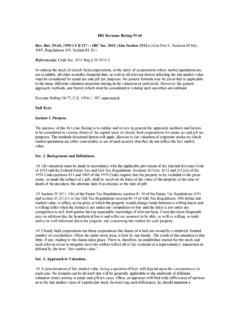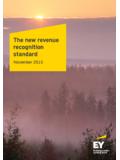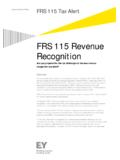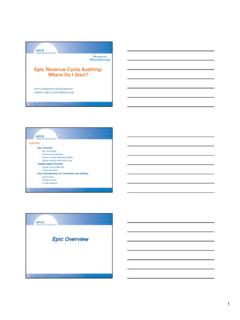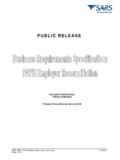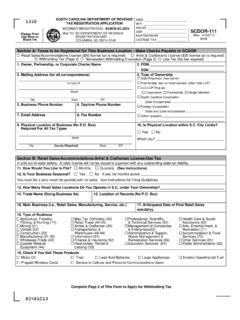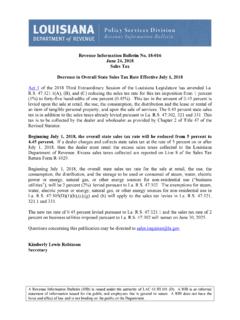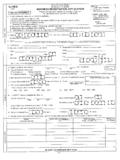Transcription of IRS Revenue Ruling 59-60 - Equity Valuation …
1 IRS Revenue Ruling 59-60 Rev. Rul. 59-60 , 1959-1 CB 237 -- IRC Sec. 2031 (Also Section 2512.) (Also Part II, Sections 811(k), 1005, Regulations 105, Section ) Reference(s): Code Sec. 2031 Reg In valuing the stock of closely held corporations, or the stock of corporations where market quotations are not available, all other available financial data, as well as all relevant factors affecting the fair market value must be considered for estate tax and gift tax purposes. No general formula may be given that is applicable to the many different Valuation situations arising in the Valuation of such stock. However, the general approach, methods, and factors which must be considered in valuing such securities are outlined.
2 Revenue Ruling 54-77, 1954-1, 187, superseded. Full Text: Section 1. Purpose. The purpose of this Revenue Ruling is to outline and review in general the approach, methods and factors to be considered in valuing shares of the capital stock of closely held corporations for estate tax and gift tax purposes. The methods discussed herein will apply likewise to the Valuation of corporate stocks on which market quotations are either unavailable or are of such scarcity that they do not reflect the fair market value. Sec. 2. Background and Definitions..01 All valuations must be made in accordance with the applicable provisions of the Internal Revenue Code of 1954 and the Federal Estate Tax and Gift Tax Regulations.
3 Sections 2031(a), 2032 and 2512(a) of the 1954 Code (sections 811 and 1005 of the 1939 Code) require that the property to be included in the gross estate, or made the subject of a gift, shall be taxed on the basis of the value of the property at the time of death of the decedent, the alternate date if so elected, or the date of gift..02 Section (b) of the Estate Tax Regulations (section of the Estate Tax Regulations 105) and section of the Gift Tax Regulations (section of Gift Tax Regulations 108) define fair market value, in effect, as the price at which the property would change hands between a willing buyer and a willing seller when the former is not under any compulsion to buy and the latter is not under any compulsion to sell, both parties having reasonable knowledge of relevant facts.
4 Court decisions frequently state in addition that the hypothetical buyer and seller are assumed to be able, as well as willing, to trade and to be well informed about the property and concerning the market for such property..03 Closely held corporations are those corporations the shares of which are owned by a relatively limited number of stockholders. Often the entire stock issue is held by one family. The result of this situation is that little, if any, trading in the shares takes place. There is, therefore, no established market for the stock and such sales as occur at irregular intervals seldom reflect all of the elements of a representative transaction as defined by the term fair market value.
5 " Sec. 3. Approach to Valuation ..01 A determination of fair market value, being a question of fact, will depend upon the circumstances in each case. No formula can be devised that will be generally applicable to the multitude of different Valuation issues arising in estate and gift tax cases. Often, an appraiser will find wide differences of opinion as to the fair market value of a particular stock. In resolving such differences, he should maintain a reasonable attitude in recognition of the fact that Valuation is not an exact science. A sound Valuation will be based upon all the relevant facts, but the elements of common sense, informed judgment and reasonableness must enter into the process of weighing those facts and determining their aggregate significance.
6 02 The fair market value of specific shares of stock will vary as general economic conditions change from normal to boom or depression, that is, according to the degree of optimism or pessimism with which the investing public regards the future at the required date of appraisal. Uncertainty as to the stability or continuity of the future income from a property decreases its value by increasing the risk of loss of earnings and value in the future. The value of shares of stock of a company with very uncertain future prospects is highly speculative. The appraiser must exercise his judgment as to the degree of risk attaching to the business of the corporation which issued the stock, but that judgment must be related to all of the other factors affecting value.
7 03 Valuation of securities is, in essence, a prophesy as to the future and must be based on facts available at the required date of appraisal. As a generalization, the prices of stocks which are traded in volume in a free and active market by informed persons best reflect the consensus of the investing public as to what the future holds for the corporations and industries represented. When a stock is closely held, is traded infrequently, or is traded in an erratic market, some other measure of value must be used. In many instances, the next best measure may be found in the prices at which the stocks of companies engaged in the same or a similar line of business are selling in a free and open market.
8 Sec. 4. Factors To Consider..01 It is advisable to emphasize that in the Valuation of the stock of closely held corporations or the stock of corporations where market quotations are either lacking or too scarce to be recognized, all available financial data, as well as all relevant factors affecting the fair market value, should be considered. The following factors, although not all- inclusive are fundamental and require careful analysis in each case: (a) The nature of the business and the history of the enterprise from its inception. (b) The economic outlook in general and the condition and outlook of the specific industry in particular.
9 (c) The book value of the stock and the financial condition of the business. (d) The earning capacity of the company. (e) The dividend-paying capacity. (f) Whether or not the enterprise has goodwill or other intangible value. (g) Sales of the stock and the size of the block of stock to be valued. (h) The market price of stocks of corporations engaged in the same or a similar line of business having their stocks actively traded in a free and open market, either on an exchange or over-the-counter..02 The following is a brief discussion of each of the foregoing factors: (a) The history of a corporate enterprise will show its past stability or instability, its growth or lack of growth, the diversity or lack of diversity of its operations, and other facts needed to form an opinion of the degree of risk involved in the business.
10 For an enterprise which changed its form of organization but carried on the same or closely similar operations of its predecessor, the history of the former enterprise should be considered. The detail to be considered should increase with approach to the required date of appraisal, since recent events are of greatest help in predicting the future; but a study of gross and net income, and of dividends covering a long prior period, is highly desirable. The history to be studied should include, but need not be limited to, the nature of the business, its products or services, its operating and investment assets, capital structure, plant facilities, sales records and management, all of which should be considered as of the date of the appraisal, with due regard for recent significant changes.
